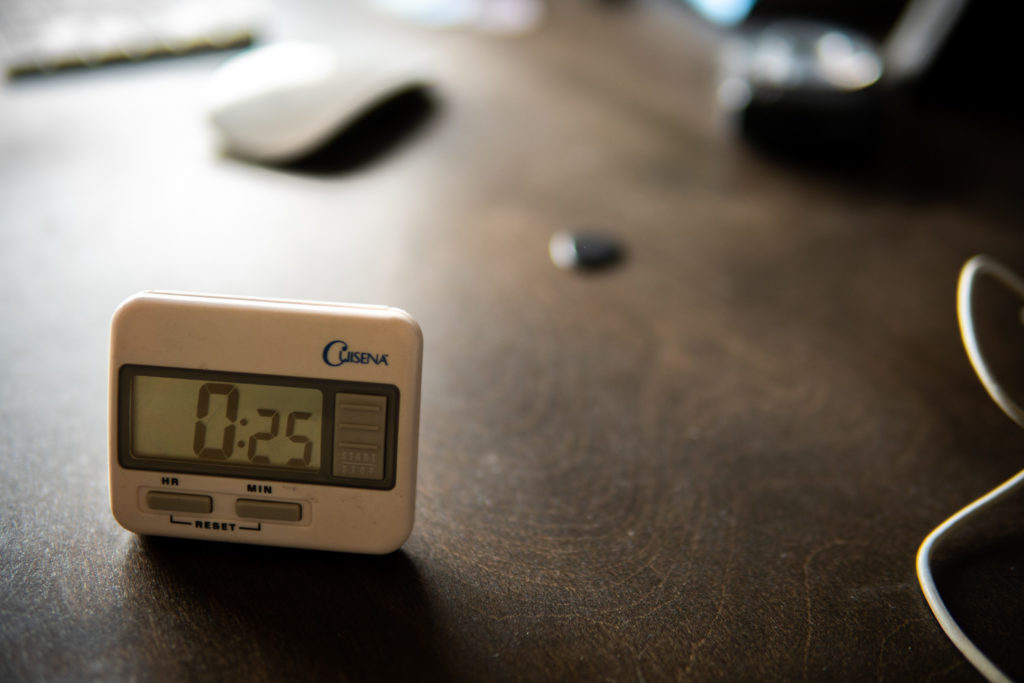The Pomodoro Technique
Sound familiar – you walk into the practise room excited and bursting with ideas. There’s a song you can’t wait to learn/a lick you’re working/an original tune you’ve been writing. You sit down with the best intentions, then half an hour later you’re on Instagram or YouTube or somewhere else in the deep recesses of the internet, eons away from those great intentions you arrived with.
How long were you actually practising for? 15 minutes? 10 minutes? 5???
If you’ve never experienced this – Stop Reading now! You’ve clocked life!
For the rest of you mere mortals, you need to start using a timer.

Start Using a Timer
A few years ago I found the Pomodoro technique, a method which employs a kitchen timer to help you stay focussed on a task. It was developed by a guy named Francesco Cirillo in the late 80’s to help him study better at university.
Pomodoro literally means ‘tomato’ in Italian. Cirillo used this word because his kitchen timer was shaped like a tomato.
I don’t use a tomato timer. Mine is a basic, cheap digital timer (pictured below). You can just as easily use the timer on your phone, although I like the tactility of dedicated tools – like timers, metronomes and tuners.
I have apps for them as well, but I prefer the real versions. I like my timer because it has a magnet on the back, so it sticks to the metal on my music stand.

How does the Pomodoro Technique work?
1) Choose a ‘task’ to work on. Learn a song, compose something, do your scales, arpeggios, whatever you want. I’ve also found it great for admin tasks like email and invoicing. Write your task down on a piece of paper.
2) Set the timer to 25 minutes. During this time you must stick to the task completely. Put your phone on airplane mode, shut the door, make a tea, get everything you need so you don’t need to go anywhere. Don’t change to another task until you’ve completed the one you started with.
If you think of a new task, write it on your piece of paper, but don’t start working on it until the first task is done. Each 25 minute block of time is referred to as one ‘pomodoro’.
3) Work on the task until the timer goes off. When you’re done, put a tick next to it on your piece of paper.
4) Have a break. Take a short break. Like 5 minutes. Get out of the chair, walk around, feed your goldfish, whatever you like. Then come back to do another pomodoro.
5) Change to the next task or keep working on the first task. What if your task requires more than 25 minutes? That’s fine, take a 5 minute break after the first 25 minutes and then return to the same task after the break. Or do a different task after the break if you think you need a change. If you do a second round of 25 minutes on a task, put another tick next to it on the paper.
6) Take a longer break after 4 pomodoros. If you’ve done 4 tasks with around 5 minutes break between each one, that’s nearly 2 hours so take a longer break. Like 20 minutes or half an hour.
7) Keep smashing pomodoros until you’ve kicked enough goals for the day. This is easier said than done. It’s not easy to keep distractions at bay. So when you do get distracted – because you inevitably will – just notice it and get back to work. Over time your focus will improve.
My experience with the Pomodoro Technique
The pomodoro technique forces me to create an intention for my practise before I start, to set a finite amount of time to work on it, and then vow not to change tasks until the timer goes off. As a result, I’m less prone to the multi-tasking trap when I use the Pomodoro Technique.
I don’t apply the Pomodoro Technique as much as I wish I did. I have productive days, I have terrible days. Sometimes I just jump from one thing to another aimlessly with some social media sprinkled in between. Other days though, I’m able to practise effectively and get things done. And now I’m more aware of how easily and often I’m distracted and how much I want to change tasks before I’m finished.
It wasn’t fun to discover how useless I was at sticking to a task. But the first step to change is awareness, so it was worth the discomfort.
RECOMMENDATIONS
- The Pomodoro Technique is supposed to help you so don’t let it become a prison. Inevitably you’ll get distracted by unavoidable life situations that occur on any given day. So be flexible when that happens.
- Tweak it a bit: Take longer or shorter breaks. Make your pomodoros shorter or longer than 25 minutes; and acknowledge that on some days you just can’t focus as well as on others.
- Combine this technique with other techniques. Check out my book review on The One Thing by Gary Keller for help on how to do the most important things in those 25 minutes of distraction-free work.
- There are loads of productivity tools now, so there’s bound to be some out there that improve your workflow. We all work and learn differently so try as many methods as you can, discard the ideas that don’t serve you, and keep the ones that allow you to get more out of your practise sessions.
For more information on the Pomodoro Technique, check out https://francescocirillo.com/pages/pomodoro-technique.
